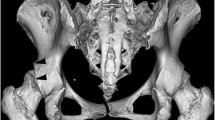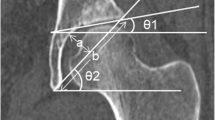Abstract
Objective
Diagnosis of acetabular retroversion based on crossover sign in the anteroposterior radiograph of the hip joint is well described. Accuracy of the crossover sign to identify global retroversion of the acetabulum in comparison to version of the acetabulum in reconstructed three-dimensional computed tomography (3D CT) scan of the hip was the aim of this study.
Materials and methods
X-rays of 500 hips were assessed regarding presence of crossover sign and its location in the upper, middle, or lower third of the acetabulum. Mean of anteversion and true retroversion (defined as less than one standard deviation below the mean of acetabular anteversion) of the acetabulum using reconstructed 3D CT scan by mathematical software was determined among 500 hips. The positive and negative crossover signs were compared to the retroversion obtained by CT scan.
Results
The average of acetabular anteversion was 12.5 ± 4.2 degrees. True global retroversion in 3D CT scans was defined as a version below 8.3 degrees. Although positive crossover sign was seen in 193 out of 500 (38 %), only 69 out of 500 (13.8 %) of hips had version below 8.3 (true retroversion) and 124 subjects had an acetabular version above 8.3. The sensitivity and specificity of crossover signs were about 82 and 70 %, respectively.
Conclusions
The crossover sign could pick up hips with less than normal anteversion with acceptable sensitivity but it has no enough specificity for being used as the sole indication for treatment.

Similar content being viewed by others
References
Biedermann R, Tonin A, Krismer M, Rachbauer F, Eibl G, Stöckl B. Reducing the risk of dislocation after total hip arthroplasty: the effect of orientation of the acetabular component. J Bone Joint Surg (Br). 2005;87:762–9.
Reynolds D, Lucas J, Klaue K. Retroversion of the acetabulum. A cause of hip pain. J Bone Joint Surg (Br). 1999;81:281–8.
Banks KP, Grayson DE. Acetabular retroversion as a rare cause of chronic hip pain: recognition of the “figure-eight” sign. Skeletal Radiol. 2007;36:S108–111.
Murray DW. The definition and measurement of acetabular orientation. J Bone Joint Surg (Br). 1993;75:228–32.
Nho JH, Lee YK, Kim HJ, Ha YC, Suh YS, Koo KH. Reliability and validity of measuring version of the acetabular component. J Bone Joint Surg (Br). 2012;94:32–6. doi:10.1302/0301-620X.94B1.27621.
Vandenbussche E, Saffarini M, Taillieu F, Mutschler C. The asymmetric profile of the acetabulum. Clin Orthop Relat Res. 2008;466:417–23. doi:10.1007/s11999-007-0062-x.
Zaltz I, Kelly BT, Hetsroni I, Bedi A. The crossover sign overestimates acetabular retroversion. Clin Orthop Relat Res. 2013;471:2463–70. doi:10.1007/s11999-012-2689-5.
Jamali AA, Mladenov K, Meyer DC, et al. Anteroposterior pelvic radiographs to assess acetabular retroversion: high validity of the “crossover-sign”. J Orthop Res. 2007;25:758–65.
Clohisy JC, Carlisle JC, Beaulé PE, et al. A systematic approach to the plain radiographic evaluation of the young adult hip. J Bone Joint Surg Am. 2008;90:47–66. doi:10.2106/JBJS.H.00756.
Larson CM, Moreau-Gaudry A, Kelly BT, et al. Are normal hips being labeled as pathologic? A CT-based method for defining normal acetabular coverage. Clin Orthop Relat Res. 2015;473:1247–54. doi:10.1007/s11999-014-4055-2.
Solooki S, Samanian M, Emami MJ, Vosoughi AR. Relationship of radiographic criteria to clinical findings in patients with femoroacetabular impingement. South Afr Orthop J. 2013;12:38–41.
Kalberer F, Sierra RJ, Madan SS, Ganz R, Leunig M. Ischial spine projection into the pelvis: a new sign for acetabular retroversion. Clin Orthop Relat Res. 2008;466:677–83. doi:10.1007/s11999-007-0058-6.
Kappe T, Kocak T, Neuerburg C, Lippacher S, Bieger R, Reichel H. Reliability of radiographic signs for acetabular retroversion. Int Orthop. 2011;35:817–21. doi:10.1007/s00264-010-1035-3.
Murtha PE, Hafez MA, Jaramaz B, DiGioia 3rd AM. Variations in acetabular anatomy with reference to total hip replacement. J Bone Joint Surg (Br). 2008;90:308–13. doi:10.1302/0301-620X.90B3.19548.
Tohtz SW, Sassy D, Matziolis G, Preininger B, Perka C, Hasart O. CT evaluation of native acetabular orientation and localization: sex-specific data comparison on 336 hip joints. Technol Health Care. 2010;18:129–36. doi:10.3233/THC-2010-0575.
Higgins SW, Spratley EM, Boe RA, Hayes CW, Jiranek WA, Wayne JS. A novel approach for determining three-dimensional acetabular orientation: results from two hundred subjects. J Bone Joint Surg Am. 2014;96:1776–84. doi:10.2106/JBJS.L.01141.
Werner CM, Copeland CE, Ruckstuhl T, Stromberg J, Seifert B, Turen CH. Prevalence of acetabular dome retroversion in a mixed race adult trauma patient population. Acta Orthop Belg. 2008;74:766–72.
Barrientos C, Diaz J, Brañes J, et al. Hip morphology characterization: implications in femoroacetabular impingement in a Chilean population. Orthop J Sports Med. 2014;2:2325967114552800. doi: 10.1177/2325967114552800. eCollection 2014.
Diaz-Ledezma C, Novack T, Marin-Peña O, Parvizi J. The relevance of the radiological signs of acetabular retroversion among patients with femoroacetabular impingement. Bone Joint J. 2013;95:893–9. doi:10.1302/0301-620X.95B7.31109.
Dandachli W, Islam SU, Liu M, Richards R, Hall-Craggs M, Witt J. Three-dimensional CT analysis to determine acetabular retroversion and the implications for the management of femoro-acetabular impingement. J Bone Joint Surg (Br). 2009;91:1031–6. doi:10.1302/0301-620X.91B8.22389.
Siebenrock KA, Kalbermatten DF, Ganz R. Effect of pelvic tilt on acetabular retroversion: a study of pelves from cadavers. Clin Orthop Relat Res. 2003;407:241–8.
Acknowledgments
This article has been obtained from a thesis submitted to the Shiraz University of Medical Sciences in partial fulfillment of the requirement for the degree of specialty in orthopedic surgery of Dr. Javad Dehghani with registration number of 8858. The project is sponsored by Bone and Joint Diseases Research Center, Shiraz University of Medical Sciences.
Author information
Authors and Affiliations
Corresponding author
Ethics declarations
Conflict of interest
The authors declare that they have no conflicts of interest.
Additional information
This study was carried out at the Bone and Joint Diseases Research Center, Shiraz University of Medical Sciences, Shiraz, Iran.
Rights and permissions
About this article
Cite this article
Hashemi, S.A., Dehghani, J. & Vosoughi, A.R. Can the crossover sign be a reliable marker of global retroversion of the acetabulum?. Skeletal Radiol 46, 17–21 (2017). https://doi.org/10.1007/s00256-016-2497-1
Received:
Revised:
Accepted:
Published:
Issue Date:
DOI: https://doi.org/10.1007/s00256-016-2497-1




